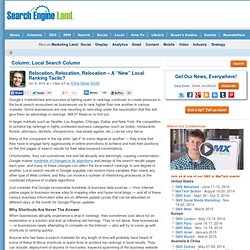

Relocation, Relocation, Relocation - A "New" Local Ranking Tactic? Google’s marketshare and success at fighting spam in rankings continues to create pressure in the local search ecosystem as businesses vie to rank higher than one another in various markets.

Some businesses are now resorting to relocating under the assumption that this will give them an advantage in rankings. Will it? Read on to find out. In larger markets such as Seattle, Los Angeles, Chicago, Dallas and New York, the competition to achieve top rankings in highly contested business categories (such as hotels, restaurants, florists, attorneys, dentists, chiropractors, real estate agents, etc.) can be very fierce. Many of the companies in the top slots “get it” to some degree or another — they know that they have to engage fairly aggressively in online promotions to achieve and hold their positions on the first pages of search results for their ideal keyword combinations.
Unfortunately, they can sometimes rise and fall abruptly and alarmingly, causing consternation. The PlaceRank Secret Behind Google’s Local Search Rankings. Most local business marketers focus solely upon their company’s web presence and don’t realize that if they shifted a portion of their promotional efforts outward in a less self-centered manner, the benefit might come back to help their own online marketing performance.

This premise is based upon a virtually-secret aspect of the PlaceRank local search algorithm. What Is PlaceRank? “PlaceRank” is named after “PageRank,“ Google’s original ranking algorithm, and it is the process by which Google collects information about all sorts of local places, and then interprets that information to generate ranking scores for each place. Marketers mostly concentrate upon business locations as places, but there are far more things that can be places, such as cities, counties, office buildings, residential addresses, parks, statues and monuments, automated teller machines, and more.
‘Place’ Is More than a Single Business Analyzing Neighborhoods. Local SEO Best Practices for Ranking in Google +Local. Local Pack/Finder Ranking Factors Google My Business Signals (Proximity, categories, keyword in business title, etc.) 25.12%Link Signals (Inbound anchor text, linking domain authority, linking domain quantity, etc.) 16.53%Review Signals (Review quantity, review velocity, review diversity, etc.) 15.44%On-Page Signals (Presence of NAP, keywords in titles, domain authority, etc.) 13.82%Citation Signals (IYP/aggregator NAP consistency, citation volume, etc.) 10.82%Behavioral Signals (Click-through rate, mobile clicks to call, check-ins, etc.) 9.56%Personalization 5.88%Social Signals (Google engagement, Facebook engagement, Twitter engagement, etc.) 2.82% Localized Organic Ranking Factors Introduction Another year, and another Local Search Ranking Factors survey is here.
My apologies for being late with it again. My thoughts and summary of the survey results can be found here on the Moz Blog, and I would love to hear your thoughts and questions in the comments section here. Definitions Local Pack.